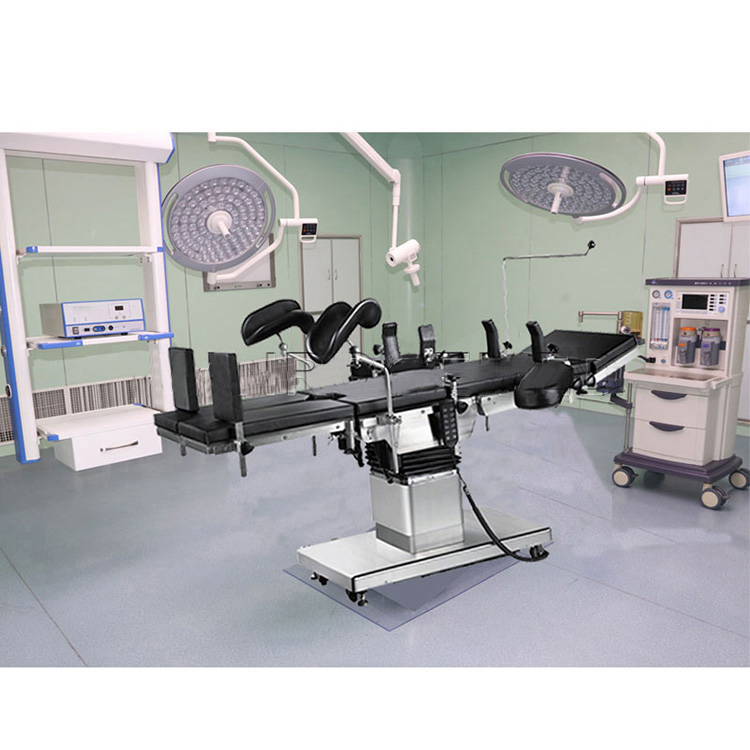Types of Operating Tables
2024-06-19
An operating table, also known as a surgical table, is a crucial piece of equipment in any operating room. It is designed to support patients during surgical procedures, providing the necessary stability and flexibility for various types of surgeries. Here’s a detailed look at the features, types, and functionalities of an operating table:
Key Features:
1. Construction:
- Material: Typically made from high-quality stainless steel or other durable materials that are easy to clean and sanitize.
- Surface: Padded for patient comfort and covered with an anti-static, waterproof material.
2. Adjustability:
- Height Adjustment: Allows surgeons to position the table at the optimal height.
- Trendelenburg and Reverse Trendelenburg: Tilts the table to position the patient’s head lower or higher than their feet.
- Lateral Tilt: Tilts the table sideways to adjust the patient’s position.
- Backrest and Leg Rest Adjustment: Allows for adjustments to the backrest and leg sections to accommodate various surgical needs.
3. Mobility:
- Wheels and Brakes: Equipped with wheels for easy movement and brakes to secure the table in place during surgery.
4. Attachments and Accessories:
- Armboards, Leg Holders, and Headrests: Various attachments to support different parts of the body.
- Anesthesia Screens: To separate the anesthesia area from the surgical field.
- Instrument Trays: Attachments for holding surgical instruments.
5. Controls:
- Manual Controls: Basic operating tables might have manual levers and cranks.
- Electric Controls: More advanced models come with electric controls for easier and more precise adjustments.
- Remote Control: Some tables include remote control for convenient adjustments during surgery.
Types of Operating Tables:
1. General Surgical Tables:
- Versatile and suitable for a wide range of surgical procedures.
- Often equipped with adjustable height, backrest, and leg sections.
2. Specialty Surgical Tables:
- Orthopedic Tables: Designed for orthopedic procedures with specialized attachments for limb positioning.
- Neurosurgical Tables: Provide precision and stability required for neurosurgery, often with advanced head fixation systems.
- Urological Tables: Feature leg holders and built-in imaging capabilities for urological procedures.
- Ophthalmic Tables: Low height and specific attachments for eye surgeries.
3. Imaging Tables:
- Designed to be compatible with X-ray, MRI, or CT imaging.
- Often made with radiolucent materials to allow imaging through the table.
Benefits:
1. Patient Safety and Comfort:
- Provides stable and secure positioning to reduce the risk of patient movement during surgery.
- Padded surfaces and adjustable positions enhance patient comfort.
2. Surgical Efficiency:
- Adjustable features allow surgeons to achieve the optimal position for different procedures, improving access and visibility.
- Attachments and accessories help in securely positioning limbs and other body parts, facilitating precise surgical interventions.
3. Hygiene and Sterility:
- Easy-to-clean surfaces and materials reduce the risk of infection.
- Seamless designs minimize areas where contaminants can accumulate.
Maintenance and Safety:
1. Regular Maintenance:
- Routine inspection and maintenance to ensure all mechanical and electrical components are functioning correctly.
- Cleaning and disinfection after each use to maintain sterility.
2. Safety Checks:
- Regularly check brakes, wheels, and locking mechanisms to ensure the table remains stable during procedures.
- Ensure all attachments are securely fastened and in good condition.
3. Training:
- Staff should be properly trained on the operation and adjustment of the table to ensure safe and efficient use.
Conclusion:
An operating table is an essential element in the surgical environment, providing the necessary support and positioning capabilities for various surgical procedures. By understanding its features, types, and benefits, healthcare facilities can choose the appropriate operating table to enhance surgical outcomes, patient safety, and operational efficiency. Regular maintenance and proper training are crucial to ensure the table’s longevity and reliable performance.



